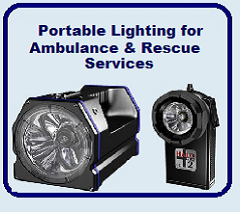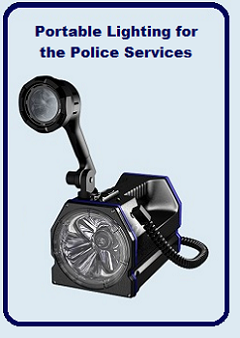White Knight produce a range of reliable, effective signal lamps for railway and related industries.
Our Halo Plus2 Signal Lamps Feature Cutting Edge Technology
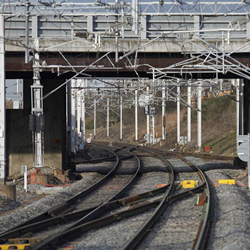
- Railtrack Approval for model HP-11R3RT
- New Generation wide-angle, ultra-bright LEDs
- Various colour combinations including BS1376 Class B output
- Low LED battery consumption giving up to 20 hours signalling
- White LED option provides up to 20 hours diffused lighting
- High operational safety ñ failure of one LED does not affect others
- Typical LED life-span 60 000 hours without colour degradation
- Powerful halogen spotlight gives 3-5 hours duration
- Optional low battery indicator (20 mins warning)
- Extremely robust construction with belt clip and polycarbonate lens
- Compact and lightweight (only 400g) including batteries
- Choice of environmentally-friendly Ni-MH battery pack, Ni-Cad or disposable “C” cells in removable cassette
- Wide range of single and 5-way mains and vehicle chargers including electronic fast chargers (charge time 1Ω – 2Ω hours)
Accessories include:
- Diffused Reflector
- Wrist Strap
- Hands-Free Chest Harness
- Carrying Handle
- Railway carriage mounting bracket
The Halo Plus 2 Signal Lamp may be specified with between 7and 21LEDs. These are mounted on a ring around the normal reflector and are controlled by a rocker switch and colour-coded pushbuttons.
Basic Operations
HP-113RT:
- Rocker Switch UP: Halogen Spotlight
- Rocker Switch DOWN: Red LEDs
- Orange Push-Button: Yellow LEDs
- Green Push-Button: Green LEDs
Signal Lamps: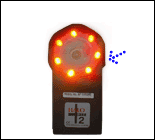
- HP-11R: 7 Red LEDs
- HP-11R2 7 Red + 7 Green(568nm) LEDs
- HP-11R3 7 Red + 7 Yellow + 7 Green (568nm) LEDs
- HP-11R2BG 7 Red + 7 Signal Green (505nm) LEDs
- HP-11R3RT 7 Red + 7 Yellow + 7 Signal Green (505nm) LEDs
- HP-11RW 7 Red + 7 White LEDs
* Other colour combinations available on request
* Network Rail Approval Certificate No:PA05/00965.
Chargers:
All chargers come either as single or 5-way units
- Standard type: Operate at 230V, 24V or 12V with a charging time of approx. 14-16 hrs. Should not be left for more than 24 hrs.
- HTS Hi-Tec type: Operate at 230V, 24V, 12V or 10-30V with a charging time of approx. 10 hours can left on charge, once fully charged a naintenance charge takes over.
- Fast Hi-Tec type: Operate at 230V, 24V or 12V with a charging time of approx. 2 hours can be left on charge, once fully charged a maintenance charge takes over.
Batteries:
- Alkaline: 3 cells will give 5 hrs halogen spot or 20 hrs LED signalling
- NiCad: 3 cells 2.2Ah will give 3 hrs halogen spot or 16 hrs LED signalling
- Ni-MH: 3 cells 3.3 Ah will give 4.5 hrs halogen spot or 20 hrs LED signalling
Please call or email us for further information on any specialist portable lighting for police, ambulance, fire and rail networks.
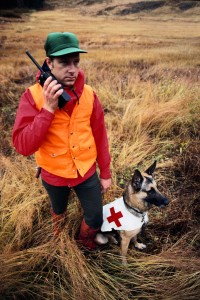 Rescue Services are there to help us when things go wrong – we all know that. But how many of us know how they started, how they operate and who pays for them?
Rescue Services are there to help us when things go wrong – we all know that. But how many of us know how they started, how they operate and who pays for them?
I found this fascinating page on the Mountain Rescue England and Wales website.
It is well worth a read, and shares some fascinating information on the risks and tenacity of the people involved.
Walking the hills for pleasure was once a pastime only for the wealthy; for others like farmers and shepherds it was a necessity and being rescued in the event of an accident was a vain hope. Walking the hills for pleasure is now a national pastime and we have the rescue services to thank for making it a safe environment for us.
Mountain Rescue services are continuously working toward improving equipment and efficiency, and for those of us who have grown up with satellite and mobile phone it is hard to imagine that once there was rarely even a phone line at the foot of a mountain or in the local hotel.
Mountain Rescue England and Wales is now a highly organized and efficient organization with HRH Prince William of Wales is their patron.
Moountain Rescue England and Wales include a full history as well some useful advice on staying safe in their book: ‘Call Out Mountain Rescue. A Pocket Guide to Safety on the Hills’ which is only £9.99, and supports a good cause.
It is available from editor@mountain.rescue.org.uk
“When I was a boy and I would see scary things in the news, my mother would say to me, “Look for the helpers. You will always find people who are helping.”
This quote by Fred Rogers, an American educator, Presbyterian minister, songwriter, author, and television host, is one of my favourites and so apt for this story!
Sadly, we all know of the tragedy of April Jones. What a lot of us don’t know is the dedication and skill of the volunteer organizations that took part in the huge search to find April – the “helpers” that Fred Rogers speaks of.
One of these was Western Beacons Mountain Rescue. The risks taken by these incredible volunteers was not lost on the family of April Jones, and her sister, Hazel, wanted to give something back – helping the helpers! She organized a sponsored skydive to raise funds for Western Beacons to put towards a new control vehicle. Over £5000.00 has been raised, although it is still possible to make donations via Just Giving.
The new vehicle will be known as “Bravo April”, a fitting tribute to the little girl, her family and the brave and selfless volunteers of Western Beacons.
Read the full story here: www.grough.co.uk/magazine/2013/06/11/rescuers-new-vehicle-will-bear-april-joness-name-after-sisters-fundraising
 Network Rail have been running Britain’s rail infrastructure since October 2002. Network Rail is a statutory corporation – a corporation that is created by statute. In the UK, this is a body without shareholders, whose powers are defined and modified by Parliament. Statutory corporations include county councils, Channel 4 and the Olympic Authority.
Network Rail have been running Britain’s rail infrastructure since October 2002. Network Rail is a statutory corporation – a corporation that is created by statute. In the UK, this is a body without shareholders, whose powers are defined and modified by Parliament. Statutory corporations include county councils, Channel 4 and the Olympic Authority.
The rail network in Britain was created and run by a number of small private railway companies until 1947 when it was nationalised and run by British Rail. In 1994 it was privatised and the running was taken over by Railtrack, a company listed on LSE.
Railtrack went into administration after the Hatfield disaster in October 2000, and Network Rail was born.
Network Rail is responsible for the railway tracks, signals, tunnels, bridges, level crossings and most stations, but not the trains which are owned by private companies. Network Rail is also not responsible for the London Underground which is run by Transport for London, the local government body responsible for most of the transport system in London.
So, if your fares go up, or your driver is on strike, don’t blame Network Rail! If your train is delayed because of a problem on the line then Network Rail will be the ones tasked to fix it.

Rail Signalling Lamp
You can keep up to date with what’s happening at Network Rail by checking the News Page of their website.
White Knight has been a leading manufacturer of Network Rail approved signalling lamps for over 25 years
 If you only keep a couple of chickens around in order to have fresh eggs every day, then raising chickens is fairly simple, but if you are thinking about supplying the market with fresh chicken and eggs, then what you don’t know about chicken farming could definitely hurt both you and your budding enterprise.
If you only keep a couple of chickens around in order to have fresh eggs every day, then raising chickens is fairly simple, but if you are thinking about supplying the market with fresh chicken and eggs, then what you don’t know about chicken farming could definitely hurt both you and your budding enterprise.
Unlike the chickens in cartoons of old, nests don’t come complete with little tubes in which the eggs roll down to a waiting basket, ready for you to pick up and cart away. Proper handling and maintaining of both your chickens and their eggs can make all the difference, not only in the number of eggs that are produced, but also the numbers of chicks that successfully hatch twenty-one days after they are laid.
Raising chickens means setting up chicken houses properly, maintaining clean and sterile conditions for producing uniform sized eggs, and knowing what to do once you gather and transfer the fertilized eggs into the incubator. Sure, you could let the chickens do it, but in today’s fast-paced, competitive world, you need to be ahead of the game, and take the proper steps to get maximum efficiency in your egg and chick production. We all know that to do that you need happy, healthy chickens, with optimum hatching conditions. There is more to hatching an egg than just putting it into an incubator and leaving it until it hatches. There is also a lot more to maintaining your chicken hatchery and chicken houses than just feeding the birds. Precautions must be taken for the safety of the chicks as well as the hens and roosters. Chicken to rooster ratios must be exactly right.
 You also need to know what to do and how to care for your chicks once they are born. For example, chicks need to be introduced to a perch once they reach six weeks of age. Chicken houses should be kept locked at all times and conditions, and personnel should be strictly monitored. Checking your chickens for avian diseases, and knowing the procedures to help prevent them, is also very important. Then, if unfortunate circumstances arise, and you notice that you have some sick birds, you need to know what to do to prevent further infestation. The last thing you need is for influenza to spread to all the rest of your chickens. Too little action too late could result in massive losses, and no business can withstand that. Also, in some cases, as in the avian flu, the potential for spreading to humans can also be quite dangerous.
You also need to know what to do and how to care for your chicks once they are born. For example, chicks need to be introduced to a perch once they reach six weeks of age. Chicken houses should be kept locked at all times and conditions, and personnel should be strictly monitored. Checking your chickens for avian diseases, and knowing the procedures to help prevent them, is also very important. Then, if unfortunate circumstances arise, and you notice that you have some sick birds, you need to know what to do to prevent further infestation. The last thing you need is for influenza to spread to all the rest of your chickens. Too little action too late could result in massive losses, and no business can withstand that. Also, in some cases, as in the avian flu, the potential for spreading to humans can also be quite dangerous.
Keeping chickens can be fun, and if you do it right, financially rewarding too!
Candling Eggs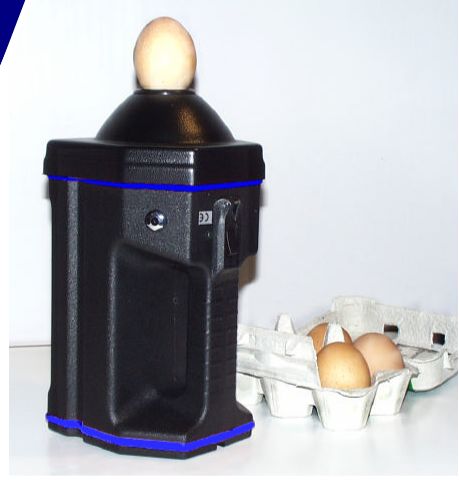
What is Egg-candling?
Egg candling sounds like a rather ineffective way of cooking an egg-but it actually has nothing to do with cooking at all. It is simply a generic term sometimes used to describe egg inspection. Candles used to be used to pass light through an egg in order to inspect the egg for diseases.
Although candles are no longer used for egg inspection, the term “egg candling” is still sometimes used.
Eggs are inspected to ensure that they are fertile and also allows identification of diseased eggs.
Ideally eggs are candled after about a week of incubation, and at this time it should be possible to see how the embryo is developing. Viable eggs will have little spidery “veins” and maybe even some movement within the egg; non-viable or in-fertile eggs will be clear and can be removed. “Addled” or diseased eggs will show up cloudy and even spotty and then should be removed and disposed of carefully.
After a further 7 days it is a good idea to inspect again, and remove any eggs that look like there has been no further development. Sometime eggs that are failing to develop will not need candling – the smell is enough to let you know!
How to Candle Eggs
Egg candling needs to be fast and efficient – shining a light through an egg for too long will also heat it and that is not a good idea. Fortunately we have come a long way from old-fashioned naked flames, and there are highly specialized and efficient torches designed specially for egg-candling.
White Knight manufacture egg inspection lights that are reliable and easy to use, and have been used regularly by DEFRA
The use of particular colours for emergency lighting is part practicality and part culture, and varies from country to country.
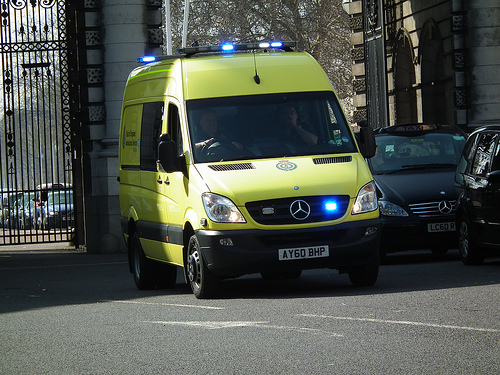 Colours and uses of emergency lighting in the UK
Colours and uses of emergency lighting in the UK
Blue – Emergency vehicles
Blue is the predominant colour for emergency vehicles in the UK and Europe. Blue is easy to see from a distance, especially in the dark.
- Flashing Blue
- Fire Engines
- Ambulances
- Police vehicles
- Emergency vehicles including HM Coastguard, Forestry Commission and even HM Revenue and Customs in certain cases
- Static Blue
- Police vehicles
Amber – Warning Lights
Amber is traditionally associated with danger, and is therefore used as warning lights on vehicles and also on the roadside. Unlike blue lights, amber lights offer no priority in traffic, and are simply used to create awareness of the vehicle’s presence.
- Flashing Amber
- Road clearance vehicles
- Rubbish collection vehicles
- Breakdown vehicles and tow trucks
- Vehicles with a maximum speed of 25 mph
- Abnormal load vehicles
- Escort vehicles for abnormal load vehicles
- Static Amber
- Road clearance vehicles
- Vehicles transporting hazardous substances
White – Flashing headlights are permitted on emergency vehicles
Flashing lights on emergency vehicles can only flash between 1 and 4 times per second and must spend an equal amount of time on and off.
Green – Doctors vehicles
Like amber lights, green lights afford the vehicle no special priority, and the driver is expected to adhere to all current traffic rules such as speed limits and traffic lights.
Red is associated with danger. It is not used by emergency services in the UK or Europe, but is widely used by emergency services in the US and some other countries.
White Knight are suppliers of emergency portable lighting to police, ambulance, fire and search and rescue services throughout the world. Visit our main site for further information

